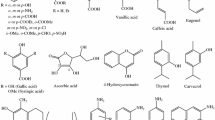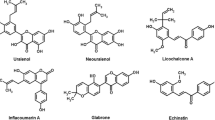Abstract
Antioxidant activity of erodiol was examined at the M05-2X/6-311+G(d,p) level of theory in the gas and aqueous phases. The structure and energy of radicals and anions of the most stable erodiol rotamer were analyzed. To estimate antioxidant potential of erodiol, different molecular properties were examined: bond dissociation enthalpy, proton affinity together with electron transfer energy, and ionization potential followed by proton dissociation enthalpy. It was found that hydrogen atom transfer is the prevailing mechanism of erodiol behavior in gas; whereas single electron transfer followed by proton transfer and sequential proton loss electron transfer mechanisms represent the thermodynamically preferred reaction paths in water.
Similar content being viewed by others
References
Bartmess, J. E. (1994). Thermodynamics of the electron and the proton. The Journal of Physical Chemistry, 98, 6420–6424. DOI: 10.1021/j100076a029.
Bors, W., Heller, W., Michel, C., & Saran, M. (1990). Flavonoids as antioxidants: Determination of radical-scavenging efficiencies. Methods in Enzymology, 186, 343–355. DOI: 10.1016/0076-6879(90)86128-i.
Cai, Y. Z., Sun, M., Xing, J., Luo, Q., & Corke, H. (2006). Structure-radical scavenging activity relationship of phenolic compounds from traditional Chinese medical plants. Life Sciences, 78, 2872–2888. DOI: 10.1016/j.lfs.2005.11.004.
Cao, G. H., Sofic, E., & Prior, R. L. (1997). Antioxidant and prooxidant behavior of flavonoids: Structure-activity relationships. Free Radical Biology and Medicine, 22, 749–760. DOI: 10.1016/s0891-5849(96)00351-6.
de Heer, M. I., Korth, H. G., & Mulder, P. (1999). Poly methoxy phenols in solution: O-H bond dissociation enthalpies, structures, and hydrogen bonding. The Journal of Organic Chemistry, 64, 6969–6975. DOI: 10.1021/jo9901485.
Fecka, I., & Cisowski, W. (2005). Tannins and flavonoids from the Erodium cicutarium herb. Zeitschrift für Naturforschung Section B, 60, 555–560.
Foti, M. C., Daquino, C., & Geraci, C. (2004). Electron-transfer reaction of cinnamic acids and their methyl esters with the DPPH. radical in alcoholic solutions. The Journal of Organic Chemistry, 69, 2309–2314. DOI: 10.1021/jo035758q.
Frisch, M. J., Trucks, G. W., Schlegel, H. B., Scuseria, G. E., Robb, M. A., Cheeseman, J. R., Zakrzewski, V. G., Montgomery, J. A., Stratmann, R. E., Burant, J. C., Dapprich, S., Millam, J. M., Daniels, A. D., Kudin, K. N., Strain, M. C., Farkas, O., Tomasi, J., Barone, V., Cossi, M., Cammi, R., Mennucci, B., Pomelli, C., Adamo, C., Clifford, S., Ochterski, J., Petersson, G. A., Ayala, P. Y., Cui, Q., Morokuma, K., Malick, A. D., Rabuck, K. D., Raghavachari, K., Foresman, J. B., Cioslowski, J., Ortiz, J. V., Baboul, A. G., Stefanov, B. B., Liu, G., Liashenko, A., Piskorz, P., Komaromi, I., Gomperts, R., Martin, R. L., Fox, D. J., Keith, T., Al-Laham, M. A., Peng, C. Y., Nanayakkara, A., Challacombe, M., Gill, P. M.W., Johnson, B., Chen, W., Wong, M.W., Andres, J. L., Gonzalez, C., Head-Gordon, M., Replogle, E. S., & Pople, J. A. (2009). Gaussian 09, Revision A1 [computer software]. Wallingford, CT, USA: Gaussian.
Glendening, E. D., Badenhoop, J, K., Reed, A. E., Carpenter, J. E., Bohmann, J. A., Morales, C. M., & Weinhold, F. (2001). NBO 5.0. [computer software]. Madison, WI, USA: Theoretical Chemistry Institute, University of Wisconsin.
Hertog, M. G. L., & Hollman, P. C. H. (1996). Potential health effects of the dietary flavonol quercetin. European Journal of Clinical Nutrition, 50, 63–71.
Hillenbrand, M., Zapp, J., & Becker, H. (2004). Depsides from the petals of Papaver rhoeas. Planta Medica, 70, 380–382. DOI: 10.1055/s-2004-818956.
Huynh, M. H. V., & Meyer, T. J. (2007). Proton-coupled electron transfer. Chemical Reviews, 107, 5004–5064. DOI: 10.1021/cr0500030.
Klein, E., & Lukeš, V. (2006). DFT/B3LYP study of the substituent effect on the reaction enthalpies of the individual steps of single electron transfer-proton transfer and sequential proton loss electron transfer mechanisms of phenols antioxidant action. The Journal of Physical Chemistry A, 110, 12312–12320. DOI: 10.1021/jp063468i.
Klein, E., Lukeš, V., & Iličin, M. (2007). DFT/B3LYP study of tocopherols and chromans antioxidant action energetics. Chemical Physics, 336, 51–57. DOI: 10.1016/j.chemphys.2007.05.007.
Kumar, S., & Müller, K. (1999). Lichen metabolites. 2. Antiproliferative and cytotoxic activity of gyrophoric, usnic, and diffractaic acid on human keratinocyte growth. Journal of Natural Products, 62, 821–823. DOI: 10.1021/np980378z.
Kumar, S., & Müller, K. (2000). Depsides as non-redox inhibitors of leukotriene B4 biosynthesis and HaCaT cell growth, 2. Novel analogues of obtusatic acid. European Journal of Medicinal Chemistry, 35, 405–411. DOI: 10.1016/s0223-5234(00)00132-x.
Leopoldini, M., Marino, T., Russo, N., & Toscano, M. (2004a). Density functional computations of the energetic and spectroscopic parameters of quercetin and its radicals in the gas phase and in solvent. Theoretical Chemistry Accounts, 111, 210–216. DOI: 10.1007/s00214-003-0544-1.
Leopoldini, M., Pitarch, I. P., Russo, N., & Toscano, M. (2004b). Structure, conformation, and electronic properties of apigenin, luteolin, and taxifolin antioxidants. A first principle theoretical study. The Journal of Physical Chemistry A, 108, 92–96. DOI: 10.1021/jp035901j.
Leopoldini, M., Marino, T., Russo, N., & Toscano, M. (2004c). Antioxidant properties of phenolic compounds: H-atom versus electron transfer mechanism. The Journal of Physical Chemistry A, 108, 4916–4922. DOI: 10.1021/jp037247d.
Litwinienko, G., & Ingold, K. U. (2007). Solvent effects on the rates and mechanisms of reaction of phenols with free radicals. Accounts of Chemical Research, 40, 222–230. DOI: 10.1021/ar0682029.
Lv, P. C., Xiao, Z. P., Fang, R. Q., Li, H. Q., Zhu, H. L., & Liu, C. H. (2009). Synthesis, characterization, and structure-activity relationship analysis of novel depsides as potential antibacterials. European Journal of Medicinal Chemistry, 44, 1779–1787. DOI: 10.1016/j.ejmech.2008.04.019.
Mandado, M., Graña, A. M., & Mosquera, R. A. (2004). AIM charge density study of simple natural phenolic antioxidants. Chemical Physics Letters, 400, 169–174. DOI: 10.1016/j.cplett.2004.10.097.
Marenich, A. V., Cramer, C. J., & Truhlar, D. G. (2009). Universal solvation model based on solute electron density and on a continuum model of the solvent defined by the bulk dielectric constant and atomic surface tensions. The Journal of Physical Chemistry B, 113, 6378–6396. DOI: 10.1021/jp810292n.
Marković, Z., Mentus, S. V., & Marković, J. M. D. (2009). Electrochemical and density functional theory study on the reactivity of fisetin and its radicals: Implications on in vitro antioxidant activity. The Journal of Physical Chemistry A, 113, 14170–14179. DOI: 10.1021/jp907071v.
Marković, Z. S., & Manojlović, N. T. (2010). Analytical characterization of lichexanthone in lichen: HPLC, UV spectroscopic, and DFT analysis of lichexanthone extracted from Laurera benguelensis (Mull. Arg.) Zahlbr. Monatshefte für Chemie, 141, 945–952. DOI: 10.1007/s00706-010-0349-6.
Marković, Z., Milenković, D., Đorović, J., Marković, J. M. D., Stepanić, V., Lučić, B., & Amić, D. (2012a). PM6 and DFT study of free radical scavenging activity of morin. Food Chemistry, 134, 1754–1760. DOI: 10.1016/j.foodchem.2012.03.124.
Marković, Z., Milenković, D., Đorović, J., Marković, J. M. D., Stepanić, V., Lučić, B., & Amić, D. (2012b). Free radical scavenging activity of morin 2′-O − phenoxide anion. Food Chemistry, 135, 2070–2077. DOI: 10.1016/j.foodchem.2012.05.119.
McLean, A. D., & Chandler, G. S. (1980). Contracted Gaussianbasis sets for molecular calculations. 1. Second row atoms, Z = 11–18. Journal of Chemical Physics, 72, 5639–5648. DOI: 10.1063/1.438980.
McQuarrie, D. A. (2000). Statistical mechanics. Sausalito, CA, USA: University Science Books.
Merrick, J. P., Moran, D., & Radom, L. (2007). An evaluation of harmonic vibrational frequency scale factors. The Journal of Physical Chemistry A, 111, 11683–11700. DOI: 10.1021/jp073974n.
Meyer, T. J., Huynh, M. H. V., & Thorp, H. H. (2007). The possible role of proton-coupled electron transfer (PCET) in water oxidation by photosystem II. Angewandte Chemie International Edition, 46, 5284–5304. DOI: 10.1002/anie.200600917.
Moa, M. J. G., Mandado, M., & Mosquera, R. A. (2006). QTAIM charge density study of natural cinnamic acids. Chemical Physics Letters, 424, 17–22. DOI: 10.1016/j.cplett.2006.04.034.
Musialik, M., & Litwinienko, G. (2005). Scavenging of DPPH. radicals by vitamin E is accelerated by its partial ionization: The role of sequential proton loss electron transfer. Organic Letters, 7, 4951–4954. DOI: 10.1021/ol051962j.
Neamati, N., Hong, H. X., Mazumder, A., Wang, S. M., Sunder, S., Nicklaus, M. C., Milne, G. W. A., Proksa, B., & Pommier, Y. (1997). Depsides and depsidones as inhibitors of HIV-1 integrase: Discovery of novel inhibitors through 3D database searching. Journal of Medicinal Chemistry, 40, 942–951. DOI: 10.1021/jm960759e.
Nielsen, J., Nielsen, P. H., & Frisvad, J. C. (1999). Fungal depside, guisinol, from a marine derived strain of Emericella unguis. Phytochemistry, 50, 263–265. DOI: 10.1016/s0031-9422(98)00517-2.
Ono, M., Masuoka, C., Koto, M., Tateishi, M., Komatsu, H., Kobayashi, H., Igoshi, K., Ito, Y., Okawa, M., & Nohara, T. (2002). Antioxidant ortho-benzoyloxyphenyl acetic acid ester, vaccihein A, from the fruit of rabbiteye blueberry (Vaccinium ashei). Chemical and Pharmaceutical Bulletin, 50, 1416–1417. DOI: 10.1248/cpb.50.1416.
Proksa, B., Adamcová, J., Šturdová, M., & Fuska, J. (1994). Metabolites of Pseudevernia furfuracea (L.) Zopf. and their inhibition potential of proteolytic enzymes. Pharmazie, 49, 282–283.
Raghavachari, K., Binkley, J. S., Seeger, R., & Pople, J. A. (1980). Self-consistent molecular orbital methods. XX. Basis set for correlated wave-functions. Journal of Chemical Physics, 72, 650–654. DOI: 10.1063/1.438955.
Reynertson, K. A., Wallace, A. M., Adachi, S., Gil, R. R., Yang, H., Basile, M. J., D’Armiento, J., Weinstein, I. B., & Kennelly, E. J. (2006). Bioactive depsides and anthocyanins from Jaboticaba (Myrciaria cauliflora). Journal of Natural Products, 69, 1228–1230. DOI: 10.1021/np0600999.
Rice-Evans, C. A., & Miller, N. J. (1996). Antioxidant activities of flavonoids as bioactive components of food. Biochemical Society Transactions, 24, 790–795. DOI: 10.1042/bst0240790.
Rice-Evans, C. A., Miller, N. J., & Paganga, G. (1996). Structure-antioxidant activity relationships of flavonoids and phenolic acids. Free Radical Biology and Medicine, 20, 933–956. DOI: 10.1016/0891-5849(95)02227-9.
Rimarčík, J., Lukeš, V., Klein, E., & Ilčin, M. (2010). Study of the solvent effect on the enthalpies of homolytic and heterolytic N-H bond cleavage in p-phenylenediamine and tetracyano-p-phenylenediamine. Journal of Molecular Structure: THEOCHEM, 952, 25–30. DOI: 10.1016/j.theochem.2010.04.002.
Trouillas, P., Marsal, P., Siri, D., Lazzaroni, R., & Duroux, J. L. (2006). A DFT study of the reactivity of OH groups in quercetin and taxifolin antioxidants: The specificity of the 3-OH site. Food Chemistry, 97, 679–688. DOI: 10.1016/j.foodchem.2005.05.042.
Wayner, D. D. M., Lusztyk, E., & Ingold, K. U. (1996). Application of photoacoustic calorimetry to the measurement of the O-H bond strength in vitamin E (α- and δ-tocopherol) and related phenolic antioxidants. The Journal of Organic Chemistry, 61, 6430–6433. DOI: 10.1021/jo952167u.
Weinhold, F., & Landis, C. R. (2005). Valency and bonding: A natural bond orbital donor-acceptor perspective. New York, NY, USA: Cambridge Academic Press.
Wright, J. S., Johnson, E. R., & DiLabio, G. A. (2001). Predicting the activity of phenolic antioxidants: Theoretical method, analysis of substituent effects, and application to major families of antioxidants. Journal of the American Chemical Society, 123, 1173–1183. DOI: 10.1021/ja002455u.
Yamamoto, Y., Miura, Y., Kinoshita, Y., Higuchi, M., Yamada, Y., Murakami, A., Ohigashi, H., & Koshimizu, K. (1995). Screening of tissue cultures and thalli of lichens and some of their active constituents for inhibition of tumor promoter-induced Epstein-Barr virus activation. Chemical and Pharmaceutical Bulletin, 43, 1388–1390. DOI: 10.1248/cpb.43.1388.
Zhao, Y., Schultz, N. E., & Truhlar, D. G. (2006). Design of density functionals by combining the method of constraint satisfaction with parametrization for thermochemistry, thermochemical kinetics, and noncovalent interactions. Journal of Chemical Theory and Computation, 2, 364–382. DOI: 10.1021/ct0502763.
Author information
Authors and Affiliations
Corresponding author
Electronic supplementary material
Rights and permissions
About this article
Cite this article
Marković, Z., Đorović, J., Dekić, M. et al. DFT study of free radical scavenging activity of erodiol. Chem. Pap. 67, 1453–1461 (2013). https://doi.org/10.2478/s11696-013-0402-0
Received:
Revised:
Accepted:
Published:
Issue Date:
DOI: https://doi.org/10.2478/s11696-013-0402-0




